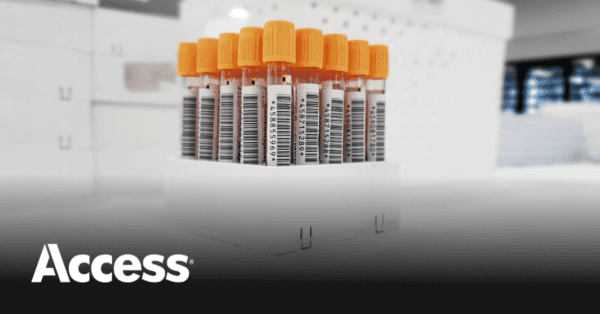
Co-authored by Access Regional Account Executives Jennifer Bula, Samantha Teschner, and David Greenberg
Completing a pathology test does not imply the automatic disposal of the sample. Lab specimens must be retained even after the completion of clinical and pathological investigations—meaning you may have a lot of samples that need to be stored appropriately and effectively.
Because of the number of specimens and the need to generate accurate results for patients and doctors, there are strict regulations that biorepositories must adhere to. From climate control to necessary quality assurance tools, moving pathological specimens to offsite storage facilities can provide compliance and peace of mind for pathology departments. Let’s take a look at why.
Advantages of Off-Site Pathology Storage
Pathology samples are crucial to detecting, diagnosing, and treating illnesses. Therefore, proper measures must be taken to ensure the specimens gathered—and stored—are appropriately handled and meet compliance guidelines.
There are many advantages to moving pathological samples offsite.
First, space and storage costs. Think of the prime real estate that can be freed up by moving samples off-site. Onsite pathological sample storage is expensive because of the resources required to do so correctly, such as freezers, to regulate the temperature and prevent specimens from deteriorating.
Second, scalability and productivity. Suppose only the most recent and working specimens are kept onsite, and all non-working samples are sent to offsite storage. In that case, it makes it easier to be organized, keeping employees productive. Eliminating the need to search through many older specimens reduces inefficiencies significantly. When older specimens are needed, a simple request to the offsite storage provider allows them to be accessed again.
Lastly, and perhaps most importantly, compliance assurance. Several risks are associated with storing pathological samples onsite, which is why many biorepositories are deciding to transition to offsite storage.
Biorepositories are legally obligated to preserve pathology specimens in a secure and safe environment, adhering to federal and state privacy laws and standards of care. According to the National Institutes of Health (NIH), all biorepositories must adhere to best practices for specimen storage and retrieval; this includes operating in effective facility environments with ambient temperature controls, good air circulation, lighting, and security.
NIH protocols also suggest that systems should be established for local and remote temperature monitoring freezers, refrigerators, and other temperature-controlled environments, as well as emergency preparedness plans and backup power supplies to safeguard specimens against unexpected events. Engaging an offsite storage provider can help to ensure specimens are managed according to these protocols, with added security and contingency measures.

Beyond Storage – A Comprehensive Information Management Checklist
Organizations of all kinds and sizes are finding themselves faced with an array of information management challenges. Some of these challenges, like the transformation of information technologies and the growth of data sets, have remained relatively unchanged for years.
Finding the Right Partner to Optimize Pathology Storage
Once you’ve decided to move pathology samples offsite, doing your research to find a reputable partner to optimize pathology storage is crucial. One should consider the following capabilities:
- Temperature-controlled environment to keep specimens from deteriorating. Your partner should be able to provide temperature and humidity logs/reports daily, weekly, or monthly.
- Access control to determine who can access certain data—and in what circumstances.
- Fire suppression technology and protection from floods, tornadoes, or any other severe weather threats to ensure business continuity.
- Commitment to safeguarding client information and strict adherence to PRISM Privacy+ standards.
- Chain of custody to track the movement and control of a sample and document each person and organization who handles it, including the date and time it was collected or transferred, and the purpose of the transfer.
- Compliance with regulatory standards, such as the NIH Guidelines for Human Biospecimen Storage, Tracking, Sharing, and Disposal.
Additionally, the provider you choose should have the expertise to assist with applying barcodes and indexing the samples, as well as provide matching electronic record documentation. This not only ensures compliance but also allows for quick location and retrieval of specimens in storage.
Furthermore, moving or relocating pathology slides, blocks, and tissues can be risky. It’s important to ensure the partner you’re working with has trained their employees on the safe and effective handling of pathology samples, Samantha Teschner recommends.
“I have clients that use Access exclusively for any moves of their pathology inventory. They won’t use a moving company or their internal facilities teams — even for internal relocations. They only trust those with the necessary training & equipment to safely handle their specimens.” – Samantha Teschner
With these considerations in mind, you’re sure to find a reputable and compliance-savvy partner to work with.
Conclusion
Effective pathology storage ensures the integrity of vital specimens and data, as well as compliance with regulatory requirements—all of which are essential for advancing medical research and patient care. Finding a partner who understands the nuances of biospecimen management, NIH protocols, and can offer tailored storage solutions is crucial.
“I had a Director of Labs at a University Medical Research Hospital tell me that by partnering with Access they can save many more lives by being able to keep biospecimen samples, logbooks, and requisition documents that accompany path samples. With all research in one place at their fingertips, their space is dedicated to patients and saving lives,” Jennifer Bula said while reflecting on her partnership with a pathology storage client.
Access is dedicated to meeting your offsite storage pathology needs with precision and care. Contact a representative to explore the storage capabilities available in your market or to find a customized solution that aligns with your specific needs. Together, we can pave the way for more efficient, secure, and compliant pathology storage practices.



